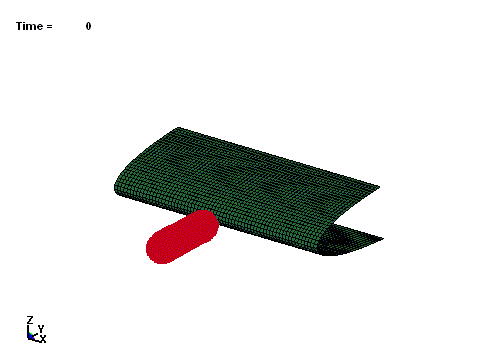GENOA-Impact
複合材進展性損傷/破壊評価解析ソフトGENOA/MCQ -機能情報
GENOA-Impact

Soft Body Impact SimulationCopyright J. Bayandor, CRASH Lab, Virginia Tech
Composite automotive and aerospace structures are subjected to various types of impact loading in service. The impact loading can be characterized into two categories: low and high velocity. The ability to accurately design for impact is key to the reliability and safe operation of the product or structure. AlphaSTAR developed and validated analytical simulation methods for assessing impact resistance characteristics of composite structures. The capability is suitable for modeling: automotive crush and crash events; impact and post-impact residual strength assessment under tension, compression, or shear; hail impact on aerospace structures, and for bird strike analysis and certification.
Challenge
Assessing composite or sandwich structures damage under impact loading is challenging as it requires integration of explicit dynamic finite element solution with damage tracking and fracture. The loading is usually in perpendicular direction to the main axis of structure exhibiting different failure mechanisms as compared to those experienced under static loading. Other challenges stem from determination of strain rate effect on material properties. Traditional methods are capable of assessing peak load but lack when it comes to simulating the failure process observed in test.
Most analytical models are adjusted to replicate test behavior, especially for high velocity impact. (i.e. bird strike simulation). The challenge is to provide a priori prediction of test behavior rather than just duplicate test behavior, especially in high strain and deformation fields. The focus of AlphaSTAR is to provide engineers with a reliable tool for assessing behavior of structures under all types of impact loading.
Implications
Relying on test alone to design for impact loading compromises the durability, reliability, integrity, and operational safety of the structure. This lead to an increase in weight to account for scatter in impact conditions under service.
How we address it
By use of multi-scale based progressive failure analysis integrated with explicit dynamic finite element solution. Most explicit finite element analysis (FEA) solvers assess damage at the lamina level whereby damage initiates at lower scale in the fiber, matrix, and interphase.
GENOA Progressive Failure Dynamic Analysis PFDA augments Explicit Dynamics (ED) finite element analysis with multi-scale composite mechanics, and damage tracking and fracture to determine all stages of damage evolution under impact, crush, or crash loading condition. The methodology determines conditions for damage/delamination initiation and growth to fracture. The damage tracking is done by identifying and accumulating damage at the “root cause” of the composite in matrix and fiber using dedicated physics based damage and failure criteria. PFDA calculates crack density, micro-cracks in the matrix, delamination within the plies, and fiber failure in tension and compression including micro-buckling.
Benefits Provided
- Capture damage and fracture evolution process under impact loading.
- Determine how failure occurs and how to fix it.
- Reduce number of tests by relying on accurate analysis and simulation methods.
- Eliminate unnecessary increase in weight by determining the residual strength post impact.
- Increased durability and reliability.
- Inclusion of material properties due to high strain rate effect.

